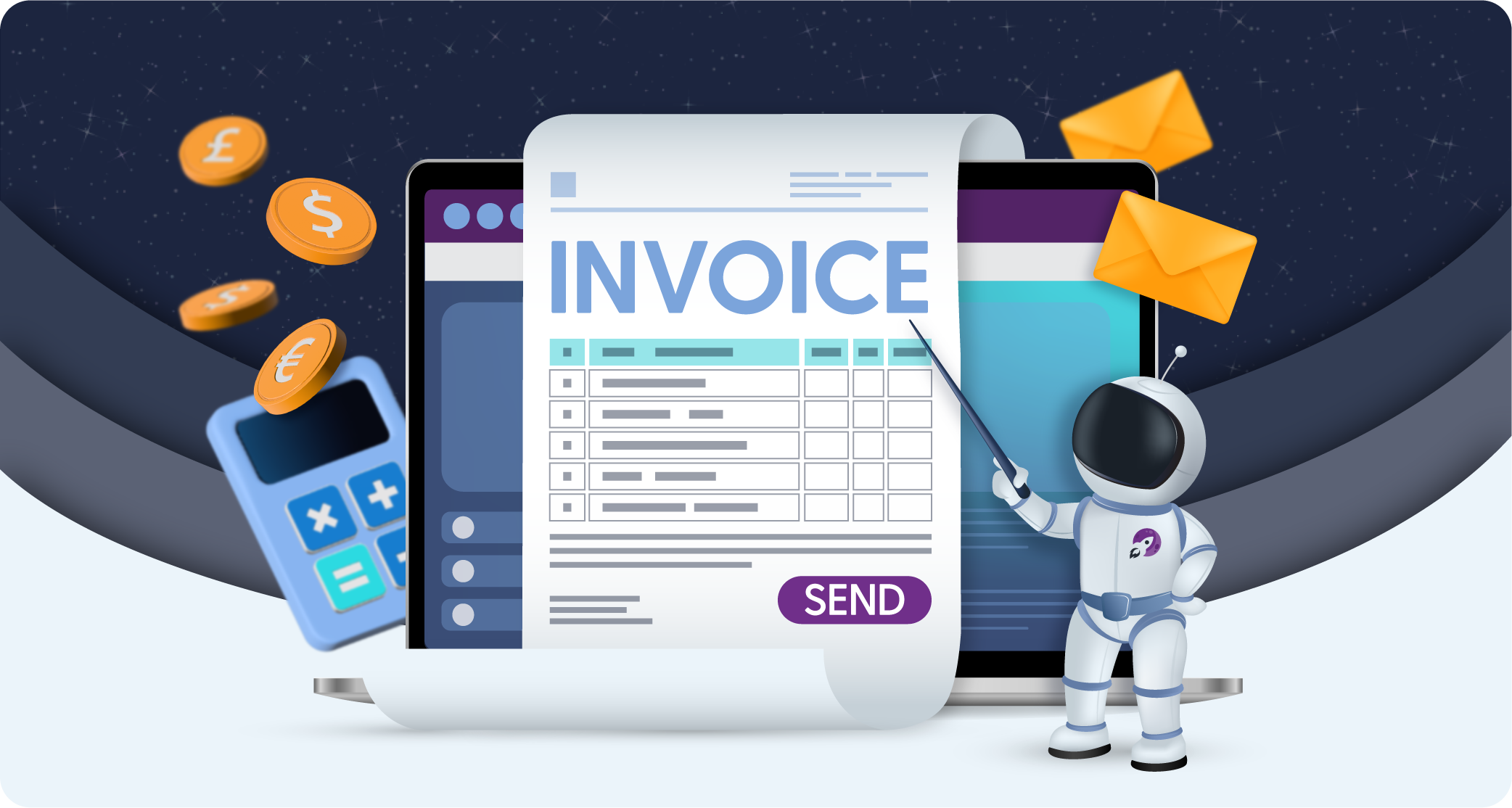

7 Reasons to Stop Sending Invoices Manually
Key takeaways
-
Manual invoicing risks human error, wasted time, and disconnection across your operations.
-
Doing things manually also makes it harder to track your financial situation, which could be problematic if you’re audited.
-
When automating parts of your business, you don’t have to lose all your old ways. It’s a good idea to integrate with the tools you currently use.
Invoicing is a permanent part of doing business. Unfortunately, it may have become so familiar to us that it blends into the furniture of our operations, and we no longer see how it could be done differently.
Many businesses and freelancers handle their invoices manually, creating each one by hand and managing payments via email chains and spreadsheets. This article will explore how this approach could be limiting your business and also how you can automate it.
We’ll also discuss some tools that can help you with automating your invoicing, getting you set up to make a positive change for your operations.
Let’s dive in:
7 reasons to stop sending invoices manually
There could be bumps and blockages in your operations that you’re not yet aware of. These are some of the ways manual invoicing could be limiting your potential:
1. Time
Despite manual invoicing seeming straightforward, it often consumes more time than expected, especially if your client base is growing. Every invoice requires data entry, formatting, and sending, followed by tracking payments and chasing overdue bills.
These repetitive tasks can quickly add up, eating into time that could be better spent on more valuable tasks like strategy, creating new campaigns, business development, or client services. Time is limited whether you’re a business owner, freelancer, or small team and the hours that go into invoicing manually build up as the months go by.
2. Error
Manual invoicing increases the risk of human error. It could be typos in the amount you charge, incorrect tax calculations, or sending invoices to the wrong contacts. These small mistakes can have big consequences, like delayed payments and damaging trust among your clients.
If clients receive inconsistent or incorrect invoices just once or twice, it can make your business appear disorganised or unprofessional, and that’s hard to recover from.
When each invoice is created by hand, it’s going to be much harder to maintain a consistent level of quality. Furthermore, the lack of standardisation can be worse if multiple team members are involved in billing.
3. Disconnection
Often functioning as a standalone task, manual invoicing can be separate from the day-to-day tools and systems used across the rest of your business. This disconnect can create friction and inefficiencies.
For example, if your invoicing process isn’t linked to your customer database, project timelines, or service delivery records, it’s easy to miss key details and spend an overly long time switching between systems to gather the right information.
This separation also makes collaboration harder. A lack of integration means each department operates in its own silo, and important financial insights might get stuck within the invoicing process instead of informing broader business decisions.
4. Cash flow
Manual invoicing can have a direct and negative impact on your cash flow. When invoices are created and sent manually, there are often delays (waiting for someone to draft the invoice, forgetting to send it on time, or missing a follow-up with a late-paying client). These delays create unnecessary strain on your cash flow, which should ideally be consistent and predictable.
Without a clear, consistent invoicing process, it’s easy for payments to slip through the cracks. If clients don’t receive timely reminders or if payment terms aren’t clearly communicated, you may find yourself chasing money well after it’s due. This can be especially challenging for small businesses or freelancers who rely on regular income to cover day-to-day costs.
5. Scaling
Invoicing manually might work when you’re managing just a few clients, but it quickly becomes unsustainable as your business grows. With more clients, projects, or product lines, the volume of invoices increases, and so does the risk of delays, errors, and missed payments.
What was once a manageable task can suddenly take up loads of valuable time and limit your ability to scale smoothly.
As your operations expand, you may need to generate invoices more frequently, handle different billing models, or manage multiple team members involved in the process. A manual approach struggles to keep pace with these demands. It lacks the flexibility, speed, and consistency needed to support a growing client base or more complex business structure.
6. Tracking
Manual invoicing makes it harder to track individual invoices and your overall financial picture. Without a centralised system, you may rely on spreadsheets, emails, or memory to monitor what’s been sent, what’s been paid, and what’s overdue. This scattered approach increases the chance of overlooking unpaid invoices or duplicating work.
Tracking becomes especially difficult over time or with more clients. You might not have a clear record of when invoices were sent, which payment terms apply, or whether a client has a history of late payments. This lack of visibility can cause cash flow issues and make financial planning less accurate.
7. Compliance
Strong financial management depends on clear, well-documented processes, and manual invoicing often falls short.
Without a reliable audit trail, your business may be exposed to compliance risks or find it difficult to demonstrate transparency and accuracy when it matters most. A structured, centralised record-keeping system would make it easier to prove that invoices were issued correctly, payments were received on time, and tax was calculated accurately.
If you’re ever audited or need to produce records for financial reporting, digging through emails, spreadsheets, or paper files can be stressful and error-prone.
What to do instead: automating invoices
If you’re still generating invoices manually, it’s worth considering automation. Automating your invoicing will save time, reduce human error, support consistent cash flow, and allow you to scale your business.
Automation also helps you stay organised, connect your operations smoothly, and ensure recurring invoices and reminders go out on time. Automated invoices are a smart and sustainable way forward, particularly for growing businesses or those looking to constantly become more efficient.
How you can automate invoices
Now that you know the value of automating your invoicing, let’s explore how to do it. For this to work successfully, you will need:
- A clear understanding of your billing process and at what points delays and errors occur
- Accurate client, pricing, and service information stored in one reliable system (i.e., a CRM, accounting software, or project management tool)
- System/s that track time, sales, or inventory (whatever applies to your operation)
Automating your invoicing process is not something that must totally transform it, you can choose to automate some aspects and leave others alone. Since setting up automations requires you to map out each step of the process, there are a lot of opportunities for customisation. The following are the main aspects you could choose to automate:
- Generating invoices (using forms)
- Sending your invoices to customers
- Sending reminders to pay
- Saving a copy of every invoice in your accounting software
- Duplicating or saving copies of every invoice into a ‘safe’ folder for your records
- Sending receipts after payments
Once you know what steps you want to automate, you can properly begin. The next big decision is choosing an invoicing software or tool that can meet your business’s needs. There are several options catering to different business sizes, structures, and requirements.
Here’s a rundown of some of the tools you could consider:
| Software | Best for | Key features | Ease of use | Free plan |
| Xero | Small to medium-sized businesses wanting full accounting features | Multi-currency accounting, invoicing, bank reconciliation, payroll, integrations, and project tracking | User-friendly with some learning curves for full features | No, plans range from £16 to £59 per month |
| QuickBooks | Small to medium-sized businesses wanting strong accounting tools | Multi-currency accounting, invoicing, mileage tracking, inventory, payroll, | Intuitive to use, popular with bookkeepers | No, plans range from £10 to £46 per month |
| FreshBooks | Small service-based businesses and freelancers that need invoicing and time tracking | Time tracking, invoicing, expense tracking, client portal, scheduled late fees, | Very easy, ideal for non-accountants | No, plans range from £8 to £48 per month |
| Wave | Small businesses and freelancers who need a free plan | Invoicing, basic accounting, receipt scanning, simple reports, and automated late payment reminders | Very easy, ideal for beginners | Yes, and a Pro plan for £11 per month |
Depending on budget, needs, and size of your business, there’ll be a tool for you; do check out each tool for an extensive list of features.
The best setups often involve integrating accounting software with either project management or CRM tools. This allows you to pull all the relevant data together to fill your invoices and may be an easier transition if you’re comfortable with the tools you already use.
For example, you may choose to integrate your accounting software with ClickUp, Asana, or Trello if you already use these to track time. In addition, a tool like Zapier (which carries out workflow automations) can be used to trigger invoice creation when tasks are marked as completed or if time is logged.
Once you’ve chosen the tools you’ll use to build your automation, you need to have an invoice template. You may already have one, but these templates ensure every invoice follows a consistent structure. A good template includes your logo, business details, and standard layout elements like itemised services, tax calculations, and payment terms. You can also pre-fill recurring details such as service descriptions, default rates, or payment instructions.
Most invoicing platforms let you save and reuse these templates so every invoice you send looks consistently polished.
Beyond templates, automation depends on defining clear rules that trigger when an invoice should be created or sent. These rules link invoicing to other parts of your workflow so you don’t have to manually initiate the process each time. For example, you might set up a rule that sends an invoice automatically when a project is marked complete in your project management tool.
Or, if you work on a retainer, you might schedule recurring invoices to go out on the first of every month. You could even base invoices on time tracked, automatically billing a client when a set number of hours is logged.
Top tip: only automate steps that are reliably predictable. When you’re starting out, you might want to build in approval steps to make sure the invoices going out are correct.
Get help with automating your business operations: nebula
If setting up invoicing automations feels like a lot to take on, you don’t have to do it alone. We specialise in building tailored automation and integration solutions that connect your existing tools (like CRMs, ClickUp, and invoicing platforms) using systems such as Make or Zapier.
Whether you need to reduce repetitive admin, improve consistency, or free up time for more valuable work, we can help design a setup that fits naturally into how your business already runs.
Our service is built to ease the pressure of manual processes and support your growth. If your current workflows are slowing you down, get in touch – we’d love to help you simplify and scale with smart, effective automation.











